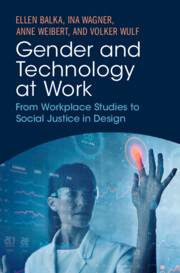Book contents
- Gender and Technology at Work
- Gender and Technology at Work
- Copyright page
- Contents
- Preface
- 0 Introduction
- Part I Gender and Technology
- Part II Gender and Technology at the Workplace
- 4 Women and Machines in the Factory
- 5 Office Automation and the Redesign of Work
- 6 Beyond the Office
- 7 AI-Based Technologies
- 8 The Computerization of Care Work
- 9 The Gendering of Computer Work
- Part III Gender and Design
- Postscript
- References
- Index
9 - The Gendering of Computer Work
from Part II - Gender and Technology at the Workplace
Published online by Cambridge University Press: 28 March 2024
- Gender and Technology at Work
- Gender and Technology at Work
- Copyright page
- Contents
- Preface
- 0 Introduction
- Part I Gender and Technology
- Part II Gender and Technology at the Workplace
- 4 Women and Machines in the Factory
- 5 Office Automation and the Redesign of Work
- 6 Beyond the Office
- 7 AI-Based Technologies
- 8 The Computerization of Care Work
- 9 The Gendering of Computer Work
- Part III Gender and Design
- Postscript
- References
- Index
Summary
The chapter starts with the invisibility of women in the early days of computer science and their substantial contributions to the field. An important part of this chapter are studies demonstrating the differences in women’s participation in the computing field in different countries. A nuanced, culturally situated intersectional analysis of gender and computing reveals that some countries (e.g. Malaysia or India) are much more open to educating and employing women IT professionals than others. Power issues continue to determine women’s opportunities to enter a career in the computing field. The chapter describes women’s work experiences in IT professions, the male-dominated working culture, and forms of gendered racism. One of the main barriers for women continues to be the typical working conditions in IT companies. But studies also show how women with time empower themselves, carving out a space that helps them deploy their skills and grow, and take control of their own careers. The chapter concludes with the question ‘What is wrong with computing?’
- Type
- Chapter
- Information
- Gender and Technology at WorkFrom Workplace Studies to Social Justice in Design, pp. 225 - 254Publisher: Cambridge University PressPrint publication year: 2024



